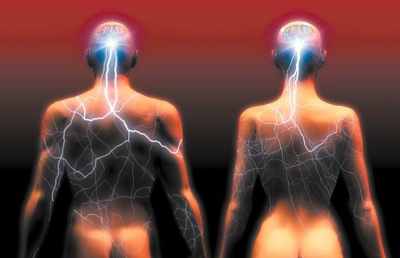 Health
Health  Health
Health  Weird Stuff
Weird Stuff Ten Surreal Attempts to Reverse Baldness
 Facts
Facts 10 U.S. Government Contingency Plans for the Unthinkable
 History
History 10 Weird Distractions from the Great Depression
 Movies and TV
Movies and TV 10 Fictional Kings Who Go from Good to Bad
 Food
Food The Fantastic Chemistry Behind Why 10 Popular Foods Taste So Good
 Technology
Technology 10 Futuristic Fungal Technologies
 History
History 10 Not-so-Spooky Events That Also Happened on October 31
 Creepy
Creepy 10 Unsettling Ghost Stories to Tell This Halloween
 Crime
Crime 10 Truly Evil People Who Used Halloween as the Perfect Cover
 Health
Health 10 Futuristic Ideas to Treat Common Medical Problems
 Weird Stuff
Weird Stuff Ten Surreal Attempts to Reverse Baldness
 Facts
Facts 10 U.S. Government Contingency Plans for the Unthinkable
Who's Behind Listverse?

Jamie Frater
Head Editor
Jamie founded Listverse due to an insatiable desire to share fascinating, obscure, and bizarre facts. He has been a guest speaker on numerous national radio and television stations and is a five time published author.
More About Us History
History 10 Weird Distractions from the Great Depression
 Movies and TV
Movies and TV 10 Fictional Kings Who Go from Good to Bad
 Food
Food The Fantastic Chemistry Behind Why 10 Popular Foods Taste So Good
 Technology
Technology 10 Futuristic Fungal Technologies
 History
History 10 Not-so-Spooky Events That Also Happened on October 31
 Creepy
Creepy 10 Unsettling Ghost Stories to Tell This Halloween
 Crime
Crime 10 Truly Evil People Who Used Halloween as the Perfect Cover
10 Cases of Natural Gender Inequality
A gender gap is a difference between women and men, besides the obvious anatomy, especially as reflected in social, political, intellectual, cultural or economic achievements or attitudes. However this list will focus on some of the biological aspects concerned with both sexes, such as the now well-known fact that men can hold their alcohol better than women, because women have a higher proportion of body fat and less stomach enzymes to metabolize the alcohol, causing 30% more of it to hit her bloodstream than a man who took the same drink.
Firstly, I apologize beforehand if any of my writing style comes off favoring either gender. I will also warn you to act as an adult concerning some of the entries on this list. Secondly, don’t let this list define you, some of these only concern either gender on average, not as an individual.

The way we get around is different to each gender, but it has been demonstrated that men are developmentally ahead in spatial awareness. Men are more abstract and Euclidian, using kilometers/miles and cardinal directions, while women often base their directions on landmarks and left-right directions. The lobule, which controls the perception of speed and the mental ability to rotate 3-D objects, is larger in men as well.
This all comes back to the hunter-gatherer days, when men led the hunt for meat and needed to have all of these perceptive tools handy for a successful hunt. On three-dimensional video tests, boys beat girls in spatial ability by a ratio of 4: 1, and the best girls were often outclassed by the lowest scoring boys.
Male brains are also programmed to concentrate efficiently on one thing at a time, while female brains are geared to be able to multitask. The reason behind this could be that neuron fibers that connect the left and right hemispheres are more plentiful in women. However some studies have shown the opposite to be true.

The male brain is larger than the female’s, having about 4% more cells and weighing 100 grams more than female brains. While this may be, each sex has equal brain weight to body weight ratio. The female brain is also more compact and more densely packed with neurons. In females, the region associated with language and social interaction is significantly larger than males, and located in both cerebral hemispheres, not just the left (as in males). While men exceed women at spatial navigation and geometry, women are exceeding at language even more. A study of 8th grade girls and boys (9th year for UK) showed the girls exceeding the boys 6: 1.
Because language centers are smaller, and only located in one hemisphere, this puts males more at risk for language disorders like dyslexia. Stuttering and speech defects appear almost exclusively in boys. But, even though they are more at risk, they average 3-4 IQ points more than women.
Interestingly enough, Dr. Louann Brizendine claims that every brain begins as a female brain, only becoming male 8 weeks after conception, when there is a surge in testosterone which reduces the language center and grows more cells in the aggression centers.

Women live longer than men in most countries. This could be due to safer life practices, or the fact that the jobs with the highest on-the-job death rate are all, predominantly, male. While both men and women are just as susceptible to mental illness, women are less vulnerable to developmental difficulties and chronic illnesses, with this possibly being due to having two X chromosomes, and therefore becoming a carrier of a disease before showing symptoms, and it could also be due to reduced exposure to testosterone. Remember, males will show symptoms of the disease if their only X chromosome is defective.
For this reason, some conditions are far more common in males than in females. Examples of X-linked recessive diseases are hemophilia and color blindness (see number 4). There is a possibility that Asperger’s Syndrome is a genetic disease as well, as it appears in 4 times as many males as females.

Women, unfortunately, do not age the same as men. Men, the same goes for you. Women have particularly denser neurons that deteriorate differently, which can lead to dementia quicker than a man’s brain would, simply because he has more of them. But women generally have faster blood flow to their brains, causing them to lose less brain tissue as they age.
Men’s skin also ages better, getting wrinkles later than women because the collagen levels don’t deteriorate as fast as they do in women. However, baldness is another X-linked recessive trait; you inherit it from your mother. This is because androgen receptors, a key hormone in the process of balding, are on the X chromosome. This means there is some truth that to see how your hair will go in the near future, look to your mother’s father, the person who gave her one of her X chromosomes. Chronic conditions are also showing a trend in being more prevalent in older women than men (conditions such as hypertension and arthritis).

Women have a greater ability to detect smells than men, and this may be linked to estrogen hormones. The structure of the nose is the same in women as men, and they don’t have any more receptors in the nose, but studies have shown smells activate a greater region in the brain in women than men. In one study, they were able to do better than men in differentiating between odors and picking up faint and slight odors. The study was repeated with younger participants with similar results.
In another unrelated study, men were given clean cotton t-shirts to sleep in for two nights. The t-shirts were subsequently sealed in plastic bags and then sent to women to smell and rate how attractive they thought the t-shirt wearer was. The most striking find of the study was that the women often picked the men who had the strongest immune systems.

Ever thought your girlfriend or wife was overreacting to a crushed finger or stubbed toe? Well, she might not have been overreacting at all, as women have more nerve receptors, which cause them to feel pain more intensely than men. Women average 34 nerve fibers per square centimeter of facial skin, while men only average 17 nerve fibers. You’re not being tougher than her by charismatically surviving a bee sting; you’re just not feeling it at her intensity.
This has far-reaching effects, as in the treatment of chronic pain sufferers may need higher dosages of painkillers. About 70% of chronic pain sufferers are women, as well. Their being sensitive and tolerant to pain is different though. Let me repeat: they are sensitive, yet tolerant to pain. They have more coping mechanisms than men do to deal with pain (i.e. more complex endorphin and oxytocin responses), and can therefore get through much more arduous parts of life, such as childbirth.

When it comes to the sense of sight, there are some big differences between men and women. While men can read finer print and are better at night vision and discerning movement, women can sense colors better, have a wider periphery of vision and have more of a chance of being a tetrachromat.
A tetrachromat has another type of cone in between the red and green (somewhere in the orange range) and its 100 shades, theoretically, would allow a woman to see 100 million different colors. Only a woman can be a tetrachromat. This is because the genes for the pigments in green and red cones lie on the X chromosome, and only women have two X chromosomes, creating the opportunity for one type of red cone to be activated on one X chromosome and the other type of red cone on the other one. In a few cases, women may have two distinct green cones on either X chromosome.
Unfortunately, it doesn’t work the same for men, as most of the color deficient men inherit two red or two green cones along with the standard blue cone, making it impossible for them to distinguish between red and green. 8 percent of men in the world have a color deficiency as compared to 0.5% of women. 2-3% of women in the world may have a fourth cone and are a tetrachromat.

Everybody knows that women and men communicate differently, and here are some observations from the scientific community that will enlighten you as to how and why.
Women are able to more adequately manipulate their facial expressions than men. However, the results are flipped when it comes to expressing and communicating anger. Women have a tendency to catch others emotions, also known as emotional contagion, although men can inhibit their expressions better than females, when cued to do so.
Women are more inclined to face each other and make eye contact when talking. Men are more likely to look away from each other. Women will tend to communicate more affection and prioritize communication more than the masculine side of the equation. When in a discussion, men are likely to debate and talk about a range of topics while the ladies may talk at length about one topic. There are a lot more tendencies each sex has when it comes to communicating, and it helps to understand this because some phrases mean something different to each gender, phrases such as “Talking about us.”

The way friendships are forged and maintained also differs between male and female. Men expect competition in companionship. They avoid communicating weakness and vulnerability as well as personal and emotional concerns. For women there is little to no problems with communicating weakness and vulnerability, even seeking out friendships during hardships. For this reason one could say that women are emotionally closer to their friends than men are.
Women tend to value and bond with their friends for listening and responding non-critically, showing support and offering comfort. On the other hand, men grow closer to each other by doing activities with each other, or doing each other favors. Young boys at school will play more vigorously, and occupy more space in their play area, than girls. Girls will opt for more sedentary games, and girls are more likely to accept a new classmate to their group, whereas a new boy will have to demonstrate his usefulness to the group.

During orgasm, both female and male genitals swell with blood, their pulse races and muscles contract involuntarily at intervals of 0.8 seconds (approximately). Some peoples mouths open. Others faces contort. The feet may arch and shake. A warm glow envelopes the body. It is during orgasm in both men and women that oxytocin floods through our bloodstream. Oxytocin, released by female orgasm, helps women lie still for a while afterwards. This further increases the likelihood of conception.
However, the difference here is the time to reach orgasm, and the functionality of each. According to sexologist Alfred Kinsley for 75% of all males, orgasm is possible to be attained within the first four minutes after initiation of sexual intercourse. For women the average time to reach orgasm is between 10 and 20 minutes. The swiftness of the male system virtually guarantees climactic orgasms for males, but is usually too quick for the female. Self stimulation is also quicker for both sexes, significantly for women.
It has also been proposed that due to the physiological similarity of men and womens genitals that the female orgasm is an “echo” of the male orgasm. As better stated by evolutionary biologist Stephen Jay Gould: “The clitoris is the homologue of the penis – it is the same organ, endowed with the same anatomical organization and capacity of response.”
On the plus side though, both sexes may experience a burst of creative thought, since orgasm produces activity in the right, creative-thinking side of the brain.

Or more accurately, each gender’s perception of it. This was originally my number 1 spot but as a Google search shows, there hasn’t been much research done on the subject, so I wasn’t sure of the credibility of some of these facts. Commenters, feel free to tear this entry apart. But otherwise go ahead and indulge.
In a 2001 study participants were asked to judge how much time had passed at an interval of 1, 3, 7 or 20 seconds. The results weren’t mind-blowing, but they showed that men regularly overshot the interval while women undershot. It also showed that the difference between sexes does not change with length of interval perceived. This could possibly purport that men feel time go by faster while women feel it goes by slower.
Women perceive time by using landmarks or milestones in time to identify other points in time (i.e. that was shortly after my mother died or that was during lunchtime) while men were more likely to state the year, date, or time something happened. As some of you may have noticed, this is similar to the relationship between men and women on spatial awareness. There is some truth to this also. The lobule that is responsible for the perception of speed and the mental ability to rotate 3-D objects is also responsible for perceiving time.








